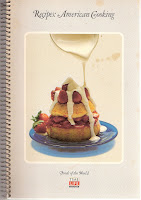After an initial foray into the exotic-in-theory, Time Life brings us home for a thorough exploration of American cooking. We start with all-purpose Americana.
The Book: Time Life, American Cooking
The Menu:
- First course: New England Clam Chowder
- Main Course: Stuffed Pork Chops, Spiced Acorn Squash and Ceasar Salad
- Dessert: Maple Mousse
This was a perfect menu for the evening of the first snowfall of our first fall in New England. Clam chowder is deeply satisfying and the substantial, fragrant, roasty pork and autumny acorn squash warm you to the bone. And, of course, nothing says New England like rich maple syrup.

The clam chowder was not the dense, gummy glop you so often get in restaurants. Although rich, the soup was very delicate in both flavor and texture. A gentle, creamy, clammy broth filled with perfect little cubes of potato and nuggets of clam. I used a bit more thyme than the recipe called for and I think it was perfect. I couldn't get my hands on salt pork so I substituted a fairly mild bacon. I think it was perfect. It lent a smokiness to the soup that otherwise would have been absent. I suspect that with salt pork the chowder would have been too mild. This recipe calls for surprisingly few clams (just 24 for a soup that has 2 cups of cream, 3 of water and 4 cups of diced potatoes). I liked it, but I think you could easily increase the number of clams if you want a more oceany soup. You could also, surely, use a stick blender to puree some or all of the potatoes before adding the clams at the end if you prefer a thicker texture.

The pork chops were clearly the highlight of the main course, although there were some oddities about the recipe. The recipe made at least twice as much stuffing as I could use and it took me three times as much cream to moisten the breadcrumbs as the recipe called for. I can't figure out if there was an error in the amount of breadcrumbs or if the authors expected you to pack a great deal more very dry stuffing into each chop than I was able to manage. Certainly if I hadn't used extra cream the stuffing would have been intolerably dry and, I think, if I'd used up all the stuffing the chops would have been very bready. With extra cream and only half the stuffing used, the chops were delicious. First richly browned on the outside, then braised in the oven in a simple gravy of chicken stock, carrots and onions. Except for one chop which was a bit thin and tough to easily make a pocket for the stuffing, this recipe was relatively quick and easy to prepare. I'll definitely make it again.

The squash, on the other hand, not so much. Each half gets filled with a mixture of butter, brown sugar, maple syrup, cinnamon, nutmeg and cloves then topped with a bit of bacon. The recipe wasn't too clear how much it said a 1/2 inch strip, but I couldn't figure out if that meant a regular strip cut to 1/2 inch wide (so about 1/2 in by 6-8 in.) or a 1/2 inch piece of a regular strip (about 1 in x 1/2 in). I opted for 1/2 a regular strip of bacon. There was really nothing successful about the recipe. The filling didn't really penetrate the flesh of the squash so it didn't have much flavor. Instead it ended up with this sort of awful pool of fat in the middle with a puddle of gunky, half-melted brown sugar in the bottom. Unpleasantly oily and sweet. Ick! The flavors are all, theoretically, nice with the squash. I think I would make some major modifications were I to try this again. First, I'd score the flesh before baking to improve the probably that the squash would actually absorb the seasonings. I think I'd brush the squash with butter and maple syrup, sprinkle on the spices, then put a little pat of butter in the cavity to melt as the squash cooked. If it needed a little more sweetness, I'd wait until near the end of the cooking, then sprinkle it with brown sugar and run it under the broiler briefly. I might also substituted bacon drippings for some or all of the butter.

The Ceasar salad was just what it claimed to be. A perfectly fine Ceasar but nothing special. I am not sure what the point was of boiling the egg for 10 seconds. That's really not long enough to make any appreciable difference. Recipes that call for coddled eggs usually suggest 1 minute boiling.

The maple mousse was at its best before I put it in the fridge for the minimum 4 hours of chilling the recipe demanded and unmolding it seemed impossible. Maybe it would have been easier if I had a proper jello-mold. No thanks! At its peak the mousse was a beautiful, light, fluffy, delicate concoction that disappeared in your mouth leaving behind only the pure, sweet taste of Sunday mornings pancake breakfasts and the sugaring-off days from Little House on the Prairie. After chilling it was a much-less-appealing, dense, not very flavorful goo. Next time I'll skip the gelatin and just serve it from glasses in its lovely, frothy state. I bet it would also be good served with crepes as dessert-ified nod to the pancake breakfast.
Next week we embark on a tour of the regional cuisines of North America. Our first stop is the eastern heartland. See you there!



















